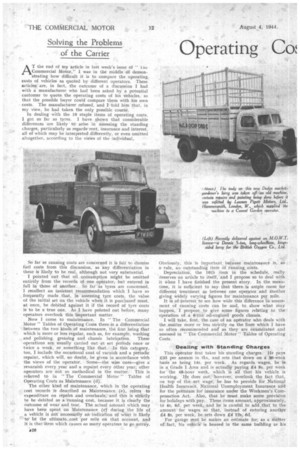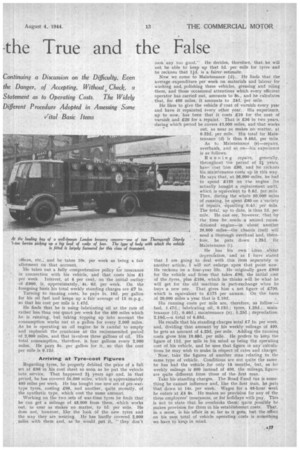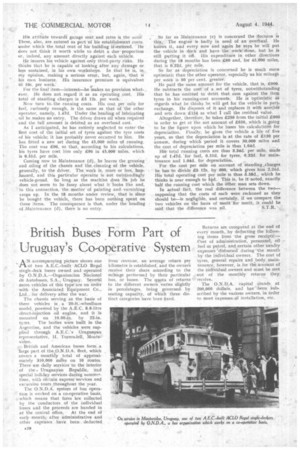Operating Cu -the True and the False
Page 28

Page 29

Page 30

If you've noticed an error in this article please click here to report it so we can fix it.
Continuing a Discussion on the Difficulty, Even the Danger, of Accepting, Withouç Check, a Statement as to Operating Costs. The Widely Different Procedure Adopted in Assessing Some tidal Basic Items
AT the end of my article in last week's issue Of " 'I ne Conimercial Motor,!' I was in the middle of demonstrating how difficult it is to compare the operating costs of vehicles as quoted by different operators. These articles are, in fact, the outcome of a discussion I had with a manufacturer who had been asked by a potential customer to quote, the operating costs of his vehicles, so that the possible buyer could compare them with his own
• costs. The manufacturer refused, and I told him that, in my view, he had taken the only possible course. In dealing with the 10 staple items of operating costs. I got as far as tyres. I have shown that considerable differences are likely to arise in assessing the standing charges, particularly as regards' rent, insurance and interest, all of which may be interpreted differently, or even omitted altogether, according to the views of the individual.
So far as running costs are concerned it is fair to dismiss fuel costs from this discussion, as any differentiation in these is likely to be real, although not very substantial.
• I pointed out that oil consumption might be omitted entirely from the records of one operator, but entered in full in those of another. So far as tyres are concerned, I recollect an insistent recommendation which I have so • frequently made that, in assessing tyre costs, the value of the initial set on the vehicle when it is purchased must, at once, be debited against it if the record of tyre costs is to be a true one. As I have pointed out before, many operators overlook this important matter.
Now I come to maintenance. In " The Commercial Motor Tables of Operating Costs there is a differentiation between the two kinds of maintenance, the first being that which is more or less regular, such as, for example, washing and polishing, greasing and chassis lubrication. These operations are usually carried out at set periods once or twice a week, or something like that. In this category, too, I include the occasional coat of varnish and a periodic repaint, which will, no doubt, be given hi accordance with the views of the operator. Some—the wise ones—give a revarnish every year and a repaint every other year; other operators are not so methodical in the matter. This is referred to in "The Commercial Motor " Tables of Operating Costs as Maintenance (d),
The other kind of maintenance, which in the operating cost records is described as Maintenance (e), refers to expenditure on repairs and overhauls, and this is strictly' to he debited as a running cost, because it is clearly the outcome of wear and tear. The actual amount which may have been spent on Maintenance (e) during the life of a vehicle is not necessarily an indication of what is likely to be the ultimate cost per mile on that account, and it is that item which causes so many operators to go astray.
Obviously, this is important because maintenance is, as a rule, an outstanding item of running costs. Depreciation, the 10th item in the schedule, really deserves an article to itself, and I propose so to deal with it when I have finished the present story. In the meantime, it is sufficient to say that there is ample room for different treatment as between one operator and another giving widely varying figures for maintenance per mile.
It is of interest to see how wide this difference in assessment of running costs can be and, to show what may happen, I propose to give some figures relating to the. operation of a &ton oil-engined goods chassis.
I will take, first, the case of an operator w.ho deals with the matter more or less strictly on the lines which I have so often recommended and as they are enumerated and assessed in " The Commercial Motor " Tables of Operating Costs.
Dealing with Standing Charges
This operator first takes his, standing charges. He pays 435 per annum in ta., and sets that down on a 50-week basis as being 14s. per week. As regards wages, he is in a Grade I Area and. is actually paying £4 as. per week for the 48-hour week, which is all that his vehicle is working. He does not, however, overlook the fact that, on top of the net wage; he has to provide for National Health Insurance, National Unemployment Insurance and for the premium lot insurance under the Workmen's Compensation Act. Also, that he must make some provision for holidays with pay. These items amount, approximately, to 4s. 6c1. per week, and he is carefal to add that to the amount for wages so that, instead of entering another 24 8s, per week, he sets down £4 12s, 6d. For garage rent he makes an estimate for; as a matter of fact, his vehicle is housed in the same building as his
offices, etc.; and he takes 10s. per week as being a fair allotment on that account.
takes out a fully comprehensive policy for insurance in connection with his vehicle, and that costs him £1 per week Interest, at 4 per cent, on the initial outlay• of £900, is, approximately, 4s. 6d. per week. On the foregoing basis his total weekly standing charges are £7 Is. Turning to running costs, he pairs Is. 10d. per gallon for his oil fuel and keeps up a fair average of 15 m.p.g., so that his cost per mile is 1.47d.
He finds that he is using IubriCating oil at the rate of rather less than one quart per week for the 400 miles which he is miming, but taking topping up into account the consumption works out at a gallon for every 2.000 miles. As he is operating an oil engine he is careful to empty and replenish the crankcase at the recommended period of 2,000 miles, and that involves three gallons of oil. His total consumption, therefore, is four gallons every 2,000 miles. He pays Ss. per gallon for it, so that the cost per mile is 0.12d.
Arriving at Tyre-cost Figures Regarding tyres, he properly debited the price of a full set at £96 in his cost sheet so soon as he put the vehicle into service. That happened 21 years ago and, in that period, he has covered 50,000 miles, which is approximately 400 miles per week. He has bought one new set of pre-wartype tyres, costing 296, and another, quite recently, of the synthetic type, which cost the same amount.
Working on the two.sets of war-time tyres he finds that' he can get a mileage of 48,000 from them, which works out, as near as makes no matter, to Id. per mile. He does not, however, like the look of the new tyres and the way they are wearing. 1-le has hardly covered 2,000 miles with them and. as he Would pgt it, " they don't
look any too good." He decides, therefbre, that. be will not be able to keep up that Id. per mile for tyres and he reckons that lid. is a fairer estimate.
Now we come to Maintenance (d). He finds that the average expenditure per week on materials and labour for washing and, polishing these vehicles, greasing and oiling them, and those occasional attentions which every efficient operator has carried out, amounts to 85., and he calculates that, for 400 miles, it amounts to .24d. per mile. • He likes to give the vehicle t coat of varnish every year and have it repainted every other year., His experience, up to now, has been that it costs £10 for the, coat of varnish and £26 for a repaint. That is 236 in two years,• during which period he covers 41,000 miles, and that works out, as near as makes no matter, at 0.22d. per mile. His total for Maintenance (d) is thus 0.46d. per mile. As tu Maintenance (e)—repairs, overhauls, and so on—his experience is as follows.
Running repairs, generally, throughout the period of 2i years, have cost him £80, and he reckons his maintenance costs up in this way. He says that, at 36,000 miles, he had to spend £120 on the engine (he actually bought a replacement unit). which is equivalent to 0.6d. per mile. Then, during the whole 50,000 miles of running, he spent £80 on a-variety of repairs, equalling 0.4th per mile. The total, up to date, is thus Id. per mile. He can see, however, that by the time he needs a second reconditioned engine—in about another 20,000 miles—the chassis itself will need a thorough overhaul and, therefore, he puts Maintenance (c).
down 1.25d. _for
He has his own ideas about depreciation, and as I have stated that I am going to deal with this item separately in another article, I will not enlarge apart that point now. He reckons on a four-year life. He originally gave £900 for the vehicle and from• that takes £96, the initial .cost of the tyres, pins 2104, which he thinks will be what be will get for the old machine in part-exchange when he buys a new one. That gives him a net figure of £700. which is equivalent to £175 per annum. On the basis of 20,000 miles a year that is 2.10d.
His running costs per mile are, therefore, as follow;— fuel, 1.47d.; lubricating oil, 0.12d.; tyres, 1.25d.; . maintenance (d). 0.46d.; maintenance (e), 1.25d.; depreciation. 2.I0d.—a total of 6.65d.
He recalls that his standing charges total 27 Is. per week. and, dividing that amount by his weekly mileage of 400, he gets an amount of 4.23d, per mile. Adding the running costs gives him 10.88d. per mile. He prefers to keep the figure of Ild, per mile in his mind as being the operating cost of his vehicle, and he uses that figure in anrcalcula• tines he may wish to make in respect of rates and charges ' Now, take the figures of another man relating to the same type of vehicle. Conditions are not quite the same he has had the vehicle for only 18 months, but, as hi= weekly mileage is' 600 instead of 400, the mileage, figures are quite different from those of the first man.
Take his-standing charges. The Road Fund tax is something he cannot influence and, like the first man, he puts that down at 14s. per week. Wages for a 48-hour week he enters at £4 8s. He makes no provision for any of the three employees' insurances, or for holidays with pay. This is not to state that fie overlooks them; quite possibly he makes provision for them in his establishment costs. That, in a sense, is his affair in so far as it goes, but the effect on his sum. total of vehicle operating costs is something we have to keep in mind. His attitude towards garage rent and rates is the same These, also, are entered as part of his establishment costs, under which the total rent of his building is-entered. lie does not think it worth while to debit a due-proportion or, indeed, any amount directly against each vehicle.
He insures his vehicle against only third-party risks. He thinks that be is capable of looking after any damage or loss sustained, in his own -workshops. In that he is, in my opinion, making a serious error, but, again, that is his own business. His insurance premium is equivalent to 10s. per week.
For the final item—interest—he makes no provision whatever. He does not regard it as an operating cost. His total of standing charges is £5 12s. per week.
Now turn to. the running costs. His cost per mile for fuel, curiously enough, is the same as that of the other operator, namely, 1.47d. Under the heading of lubricating oil he makes no entry. The driver draws oil when required and the full amount is debited as an overhead cost.
As I anticipated, he has entirely neglected to enter the first Cost of the initial set of tyres against the tyre costs of his vehicle; it has probably never occurred to him. He has fitted a new set during the 45,000 miles of running. The cost was £96, so that, according to his calculations, his tyres have cost him only £96 in 45,000 miles, which is 0.5Id. per mile.
Coming now to Maintenance (d), he leaves the greasing and oiling of the chassis and the cleaning of the vehicle, generally, to the driver. The work is, more or less, hap.. hazard, and this particular operator is not outstandingly vehicle-proud. So long as the machine does its job he does not seem to be fussy about what it looks like and, in this connection, the matter of painting and varnishing crops up. In the 18 months under review, that is since he bought the vehicle, there has been nothing spent on these items. The consequence is that, under the heading of Maintenance (d), there is no entry. ' So far as Maintenance (e) is concerned the decision ;s this. The engine is badly in need of an overhaul. He knows it, and every now and again he says he will put the vehicle in dock and have the work done, but he is still putting it off. His expenditure in other directions during the 18 months has been £,60 and, for 45,000 miles, that is 0:32d. per mile.
So far as depreciation is concerned he is much more optimistic than the other operator, especially as his mileage per week is 50 per cent. greater.
He paid the same amount for the vehicle, that is, £900. He subtracts the cost of a set of tyres, notwithstanding that he has omitted to debit that sum against the item tyres in his running-cost accounts. He is optimistic as regards what he thinks he will get for the vehicle in partexchange. He disposes of it and replaces it with another and sets down £154 as what I call the residual value.
• Altogether, therefore, he takes £250 from the initial £900 in order to get at the net amount of 2650, which is going to be the figure upon which he bases his calculations for depreciation. Finally, he gives the vehicle a life of five years, so that the depreciation is at the rate of £130 per annum, during which period it covers 30,000 miles and the cost of depreciation per mile is thus 1.04d. His total running costs are thus 3.34d. per mile, made up of 1.47d. for fuel, 0.51d. for tyres, 0.32d. for maintenance and 1.04d. for depreciation.
For the cost per mile on account of standing ,charges he has to divide £.5 12s. by 600, which gives him 2.24d. His total operating cost per mile is thus 5.58d., which he thinks is near enough to 50. This is, be it noted, exactly half the running cost which the other man sets down.
In actual fact, the real difference between the two— supposing that the costs of each were reckoned as they should be—is negligible, and certainly, if we compare the two vehicles on the basis of merit for merit, it could be
said that the difference was nil. S.T.R. ,




















































